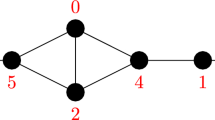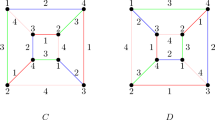Abstract
A set \(S \subseteq V(G)\) is a k-distance independent set of a graph G if the distance between every two vertices of S is greater than k. The k-distance independence number \(\alpha _k(G)\) of G is the maximum cardinality over all k-distance independent sets in G. A k-distance coloring of G is a function f from V(G) onto a set of positive integers (colors) such that for any two distinct vertices u and v at distance less than or equal to k we have \(f(u) \not = f(v)\). The k-distance chromatic number of a graph G is the smallest number of colors needed to have a k-distance coloring of G. The k-distance independence numbers and 2-distance chromatic numbers of Cartesian products of cycles are considered. A computer-aided method with the isomorphic rejection is used to determine the k-distance independence numbers of Cartesian products of cycles. By using these results, several lower and upper bounds on the maximal cardinality \(A^L_q(n, d)\) of a q-ary Lee code of length n with a minimum distance at least d are improved. It is also established that the 2-distance chromatic number of G equals \(\left\lceil \frac{|V(G)|}{\alpha (G^2)} \right\rceil \) for \(G=C_m \Box C_n \Box C_k\), whenever \(k \ge 3\) and \((m,n)\in \{(3,3), (3,4), (3,5), (4,4)\}\) or k, m and n are all multiples of seven. Moreover, it is shown that the 2-distance chromatic number of the three-dimensional square lattice is equal to seven.


















Similar content being viewed by others
References
Astola, H., Tabus, I.: Bounds on the size of Lee-codes. In: 8th International Symposium on Image and Signal Processing and Analysis (ISPA 2013)
Bogdanova, G.T., Brouwer, A.E., Kapralov, S.N., Östergård, P.R.J.: Error-correcting codes over an alphabet of four elements. Des. Codes Cryptogr. 23, 333–342 (2001)
Bogdanova, G.T., Östergård, P.R.J.: Bounds on codes over an alphabet of five elements. Discret. Math. 240, 13–19 (2001)
Horak, P., Albdaiwi, B.F.: Diameter perfect Lee codes. IEEE Trans. Inf. Theory 58, 5490–5499 (2012)
Huffman, W.C., Pless, V.: Fundamentals of Error-Correcting Codes. Cambridge University Press, Cambridge (2003)
Kim, J.-L., Kim, S.-J.: The 2-distance coloring of the Cartesian product of cycles using optimal Lee codes. Discret. Appl. Math. 159, 2222–2228 (2011)
Klavžar, S., Vesel, A.: Computing graph invariants on rotagraphs using dynamic algorithm approach: the case of (2,1)-colorings and independence numbers. Discret. Appl. Math. 129, 449–460 (2003)
McKay, B.D.: Nauty user’s guide (version 2.5). Computer Science Department, Australian National University (2013). http://pallini.di.uniroma1.it/
Quistorff, J.: New upper bounds on Lee codes. Discret. Appl. Math. 154, 1510–1521 (2006)
Shao, Z., Vesel, A.: A note on the chromatic number of the square of the Cartesian product of two cycles. Discret. Math. 313, 999–1001 (2013)
Sopena, É., Jiaojiao, W.: Coloring the square of the Cartesian product of two cycles. Discret. Math. 310, 2327–2333 (2010)
Vaessens, R.J.M., Aarts, E.H.L., van Lint, J.H.: Genetic algorithms in coding theory-a table for \(A_3(n, d)\). Discret. Appl. Math. 45, 71–78 (1993)
Acknowledgments
This work was supported by the National Natural Science Foundation of China under the Grant 61309015, China Postdoctoral Science Foundation under the Grant 2014M560851, National Basic Research Program of China under the Grants 2013CB329601 and 2013CB329603, the Ministry of Science of Slovenia under the Grant 0101-P-297.
Author information
Authors and Affiliations
Corresponding author
Additional information
Communicated by Sandi Klavžar.
Rights and permissions
About this article
Cite this article
Shao, Z., Vesel, A. & Xu, J. The k-Distance Independence Number and 2-Distance Chromatic Number of Cartesian Products of Cycles. Bull. Malays. Math. Sci. Soc. 41, 1377–1391 (2018). https://doi.org/10.1007/s40840-016-0397-0
Received:
Revised:
Published:
Issue Date:
DOI: https://doi.org/10.1007/s40840-016-0397-0




